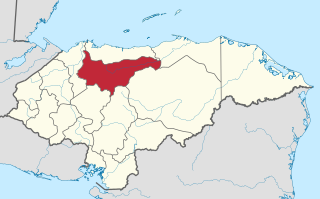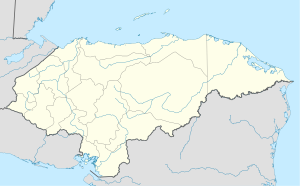
Yoro is one of the 18 departments into which Honduras is divided. The department contains rich agricultural lands, concentrated mainly on the valley of the Aguan River and the Sula Valley, on opposite ends. The departmental capital is Yoro. The department covers a total surface area of 7,939 km² and, in 2005, had an estimated population of 503,886 people. It is famous for the Lluvia de Peces, a tradition by which fish fall from the sky during very heavy rains.
La Paz is the capital city of the La Paz Department of Honduras. The town, founded in 1792, has a population of 32,450.

Nacaome, with a population of 21,310, is the capital city of the Valle department of Honduras and the municipal seat of Nacaome Municipality. It is a manufacturing and commercial center located on the banks of the Nacaome River.

El Progreso is a city, with a population of 120,600, and a municipality located in the Honduran department of Yoro.
El Porvenir is a town, with a population of 5,202, and a municipality in the Honduran department of Atlántida. The largest town of the Municipality is El Pino, with a population of 6,304.
Pimienta is a town, with a population of 13,530, and a municipality in the Honduran department of Cortés. The name means "pepper" in Spanish.
San Manuel is a town, with a population of 14,260, and a municipality in the Honduran department of Cortés.
Chinacla is a municipality in the Honduran department of La Paz.
Marcala is a town, with a population of 15,050, and a municipality in the Honduran department of La Paz. The region is known for its coffee production, boasting the first "protected origin denomination" for coffee. Marcala has been designated as a center of Lenca Trail, a government and United Nations sponsored development effort to encourage tourism to Lenca communities. It offers visitors perspective on the culture of indigenous people and provides new markets for their traditional crafts.
Morazán is a town, with a population of 22,240, and a municipality in the Honduran department of Yoro. This political division of 50,930 people is in the north, located between the city of Yoro and the municipality of El Negrito, north of the Nico Pijol National Park.
Olanchito is a municipality in the department of Yoro, Honduras, and a town with a population of 49,750 as of 2023. The municipality was founded in 1530 and comprises 70 villages, approximately 300 hamlets, and a population of 124,286. It is located 107 miles (172 km) northeast of Tegucigalpa, the country's capital. Olanchito operates in the Central Time Zone, with a UTC offset of -6 hours. The city is the birthplace of many popular figures of Honduran literature such as Ramón Amaya Amador, whose manuscripts, collection of books, writing table, and ashes are located in Olanchito. Known locally as the Civic City, Olanchito's main industry is agriculture.
Santa Rita is a town and a municipality in the Honduran department of Yoro. The Humuya River passes through it.
Sulaco is a municipality in the Honduran department of Yoro.
Yorito is a municipality in the department of Yoro, Honduras.
San José de Colinas is a town, with a population of 5,215, and a municipality in the Honduran department of Santa Bárbara.
San Luis is a town, with a population of 5,857, and a municipality in the Honduran department of Santa Bárbara.
San Lorenzo is a city, with a population of 35,560, and a municipality in the Honduran department of Valle.
Gualán is a town and municipality in the Guatemalan department of Zacapa. It is located in the Eastern part of the country about 165 Kilometers from Guatemala City on route CA-9.

The lluvia de peces, also known as aguacero de pescado, is a phenomenon that has been occurring yearly for more than a century in Yoro, Honduras, in which fish are said to fall from the sky. It occurs up to four times in a year. It has attracted the attention of scientists, as well as documentary coverage by the History Channel in the United States.




